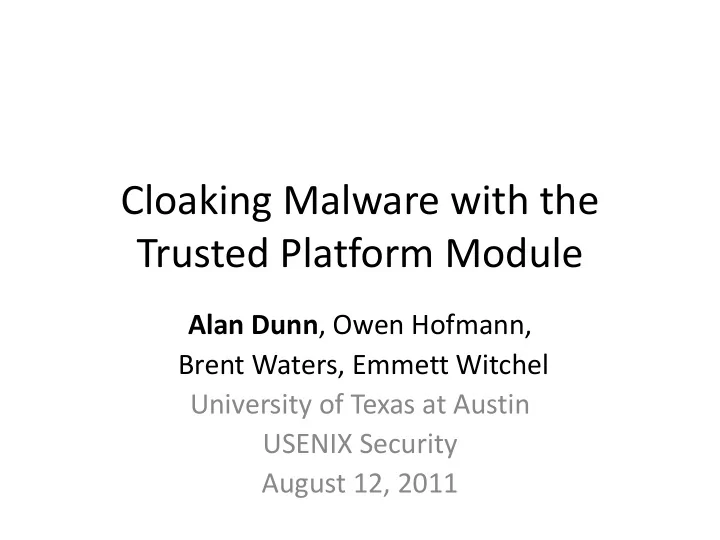

Cloaking Malware with the Trusted Platform Module Alan Dunn , Owen Hofmann, Brent Waters, Emmett Witchel University of Texas at Austin USENIX Security August 12, 2011
Trusted Computing • Goal: Secure environment for computation • Trust rooted in hardware • Most familiar: Trusted Platform Module (TPM) – Standard by Trusted Computing Group (TCG) – IC in x86 machines connected to southbridge – Widely deployed (> 350 million TPMs)
Uses of Trusted Computing • Typical: TPM provides hardware root of trust – Store cryptographic hash of executed software – Perform cryptography, store secret keys – Provide hardware-protected execution environment • Ours: TPM provides hardware cloak for malware – Only run unmodified malware – Store malware secret keys – No monitoring/debuggers/virtualization
Conficker B Explanation Conficker B Analysis ! get_updates() gen_domains() “8/12/11” “8/13/11” Secure date www.google.com date = get_date_from_web() mechanism Contact calculate domains… websites aijuer.com TPM can help malware writers achieve this goal: lkpexhjz.org Execute computation securely in non-analyzable … environment for domain in domains: content = fetch_content(domains) if (check_sig(content)) apply_update(content) Goal for malware writers: Secure and hidden malware sub- computation
Outline • Protocol Overview • Protocol • Implementation • Defenses
Protocol Overview Infected Platform Malware Distribution Platform (MDP) main() … sensitive_calc() … sensitive_calc() … normal_calc() … • Put platform in known non- Infection analyzable state Payload • Restrict payload decryption Loader to non-analyzable state Late launch environment
Put platform in non-analyzable state • Suspend all system software, jump into known software state • Late launch performs jump, records program jumped to via hash Infected Platform Infection Payload Loader Late launch environment
Restricting payload decryption • TPM controls private key use for keypairs it generates • Binding key constrained to use in non-analyzable state • Certificates show Endorsement Key (EK) belongs to legitimate TPM • Remote attestation proves binding key generated by same party as EK, so payload only decryptable in late launch Malware Distribution Platform Infected Platform (MDP) Binding key Malicious payload
Late Launch • SENTER instruction transfers control to binary, sets TPM register based upon cryptographic hash of binary – Allows binary to execute securely: stop other cores, turn off interrupts • For malware: – Transfer control to Infection Payload Loader (IPL) – IPL hash satisfies key use constraint – IPL decrypts, transfers control to malicious payload
Validating the Binding Key • Endorsement Key (EK) – unique identifying key, certified by TPM manufacturer • Sign binding key with Sign(EK, M 1 ) P1 EK? Forbidden! • EK identifying, Correlate A transactions compromises anonymity P2 Sign(EK, M 2 )
TPM Identity (EK) with Indirection (AIK) • Attestation Identity Keys (AIKs) fix anonymity • Privacy CA vouches that AIK represents EK • Problem: Privacy Establish EK Sign(AIK 1 , M 1 ) P1 legitimacy, CAs don’t exist AIKs proxy for EK C vouches for • Solution: Malware A C legitimacy of AIKs Distribution Platform acts as P2 Sign(AIK 2 , M 2 ) Privacy CA C is a Privacy CA
Can malware generate an AIK? • Owner AuthData required for AIK generation • Owner AuthData not needed on platform, used rarely • Capture from keylogging or from memory (Windows: cached for days)
Remote attestation details Infected Platform Malware Distribution Platform (MDP) Phase 1: cred AIK represents EK 1) Generate AIK 2) PK EK , PK AIK , Sign(SK manuf. ,H(PK EK )) 3) Verify EK sig 4) Enc(PK EK , cred || H(PK AIK )) 5) Activate AIK: if H(PK AIK ) matches AIK generated on that platform, TPM releases cred
Remote attestation details (cont’d) Infected Platform Malware Distribution Platform (MDP) Phase 2: Prove binding key is from TPM that controls EK 1) Generate binding key with use constraint 2) PK bind , key use constraint, cred, Sign(SK AIK ,H(PK bind ||key use constraint)) 3) Verify use constraint, cred 5) Late launch, Malicious payload 4) Send encrypted decrypt and malicious payload run payload
Implementation • Protocol until late launch (w/TrouSerS) • Late launch (via Flicker v0.2) on Intel platforms – Infection Payload Loader (IPL): decrypt, execute payload – IPL run appears as 3 second system freeze on Infected Platform due to TPM key operations in late launch • Three malicious payloads – Conficker B-like example • Secure time via Ubuntu package manifests – DDoS timebomb – Secret text search
Defense: Whitelisting late launch binaries • Hypervisor-level whitelisting – Trap on SENTER , check late launch binary • List of hashes of whitelisted binaries • Digitally sign binaries, whitelist signing keys • Problems – Requires hypervisor: tough for home users – Late launch binary updates – Signatures: Revocation, trust management (certificate chains)
Defense: Manufacturer Cooperation • Manufacturer breaks TPM guarantees for analyst • Fake Endorsement Key (EK) – Manufacturer produces certificate for EK that is not TPM controlled – Problem: EK leak can compromise TPM security properties • Fake Attestation Identity Key (AIK) – Manufacturer uses EK to complete AIK activation for AIK that is not TPM controlled – Problem: AIK requests need manufacturer response online
Defense: Physical Compromises • TPM compromise has been demonstrated – Simple: Grounding LPC bus allowed faking of TPM code measurement – Exotic: Etching away casing, probing around tamper-resistant wiring allowed EK recovery • Industry incentives to fix • Further discussion in paper (e.g. cold boot)
Conclusion • TPM can cloak malware sub-computations, hiding them from analysts • Concrete implementation of TPM-based malware cloaking – Remote attestation – Late launch • Strengthening TPM guarantees makes attack more resilient
Recommend
More recommend